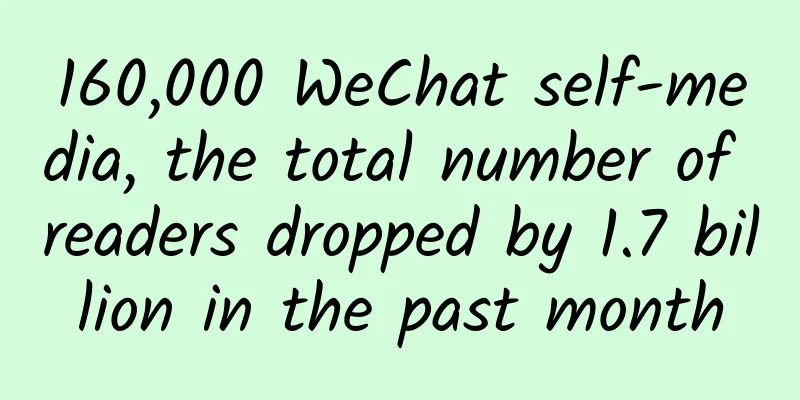160,000 WeChat self-media, the total number of readers dropped by 1.7 billion in the past month

|
On October 11, the "New Media Ranking" released the "Monthly Report of the Top 500 WeChat Accounts in China in September", which made the possibility of "declining WeChat self-media reading numbers" more than just a "guess". The report said that after comparing the top 500 WeChat self-media accounts in September with those in August, it was found that 60.4% of the accounts were still increasing their publishing intensity (the so-called "publishing intensity" refers to the number of posts and articles per day, the same below), while only 30.2% had an increase in average reading numbers, and 36.6% of the accounts fell into the embarrassing situation of "the harder they work, the less people read them", and the situation of the entire sample was similar. Let’s take a closer look at this report. Xinbang did not publish a monthly trend chart of total readings this time, but instead drew a scatter plot. Xinbang cross-compared the changes in the average number of daily posts and the average number of reads per post. From the chart, only 12.6% of self-media had an increase in posting intensity and average number of reads, 36.6% increased posting intensity but the average number of reads decreased, 14.4% reduced posting intensity but the average number of reads increased, and 21.8% had a decrease in posting intensity and average number of reads. I found two sets of data with declining reading numbers: 36.6% of self-media increased their publishing intensity in September, but their average reading numbers were declining. At the same time, 21.8% of self-media reduced their publishing frequency, and their reading numbers were also declining. Is this true? Taking the top two celebrity accounts on the New List as an example, the official WeChat accounts of People's Daily and CCTV News had a total reading volume of 40.04 million and 32.23 million in August, and the data in September dropped to 38.99 million and 28.32 million. Interested users can compare the monthly rankings of China's top 500 WeChat accounts (information category) in August and September, which include the total reading volume of each account in August and September. In addition to the top 500, Xinbang released the full sample data it captured this time. I saw that Xinbang collected a total of 167,000 WeChat public accounts as samples, of which 70% were active (Xinbang considers accounts that have posted content within a specified time as active), that is, from September 1 to September 30, Xinbang monitored data from more than 110,000 WeChat public accounts. The conclusion is that after comparing the data in September with that in August, it was found that 54.2% of the accounts were still increasing their posting intensity, and only 34.2% had an increase in average readings compared to the previous month, which is similar to the data of the top 500 accounts. Xinbang also made a scatter plot, in which 30.8% of the accounts increased their posting intensity, but their average readings decreased; 23.5% of the accounts had a decrease in both posting intensity and average readings. These two data are basically the same as those of the top 500 WeChat accounts in China. In other words, the situation encountered by more than 110,000 WeChat self-media accounts and the top 500 WeChat self-media accounts in China is basically the same: from August to September 2015, the number of readers of most self-media may have declined. Another intuitive data is: when the monthly survey sample remains at 160,000 subscription account samples, the data released by Xinbang shows that the total readings in August (163,000 WeChat accounts) were 28.6 billion, and the total readings in September (167,000 WeChat accounts) were 26.9 billion, a decrease of 1.7 billion. In June and July, the total readings in June (148,000) were 27.7 billion, and in July (156,000) were 28.6 billion. Regarding this phenomenon, Xinbang believes that "reading numbers reflect the vitality of (WeChat) users". The full text of its comment is as follows: "The intensity of posting reflects the confidence of the operator, and the number of readings reflects the vitality of users. Both can effectively reflect the development trend of the entire platform. It is worth noting that there are many factors that affect the number of posts and readings. In addition to the subjective wishes of operators and users, there are also other factors such as platform adjustments and national laws and regulations. Therefore, the development of the platform needs further observation." I agree with the conclusion of Xinbang. It is obviously unreasonable to "r-conclude" that the overall reading number of WeChat self-media is declining based on a sample of hundreds of thousands and a few months of individual data. The main purpose of this analysis article is to hope that self-media friends can pay attention to this phenomenon and find ways to solve the problem from their own perspective. The individual WeChat big account operators mentioned in the previous article also told me that their reading numbers have recently recovered or even exceeded the previous data. |
<<: A collection of the pitfalls you will encounter when adapting to iOS 9
>>: Recommended by experts: iOS custom drop-down line animation
Recommend
Data Brother · Super Cargo Operation + Pitcher Online Crash Course, quickly improve operations and become familiar with pitching skills
Data Brother · Super Cargo Operation + Pitcher On...
How did Meilishuo attract its first 1 million users?
Meilishuo was founded in 2009 and now has nearly 1...
Dou Shang 6.28 The latest and most comprehensive inappropriate methods on the Internet break and explain more than 20 methods
Doushang 6.28 The latest and most complete Douyin...
A must-read for marketers: 5 senses and abilities you must master!
I have read many marketing books and found that t...
How much does it cost to customize a nutritional supplement mini app in Xinyu?
According to industry insiders, mini programs wil...
How to maximize the effectiveness of video, information flow and other platforms?
Today’s article is about: Marketing strategies fo...
An information flow advertising landing page worthy of collection by all industry professionals
We all know that the task of most landing pages i...
Use these 5 points to increase product user growth!
As the Internet's traffic dividend fades, gro...
The latest gamification operation methodology in 2020!
Preface How can you make users addicted to your p...
The 10 most popular growth hacking strategies in China in 2017
Any growth practice starts with small things. In ...
A different way to promote APP: Analysis of the operation strategy of "Youlin"!
The author of this article is Tian Zuo, who has b...
Information flow placement skills to increase advertising CTR by 3 times!
Today I will share with you an optimization case ...
When planning a hit event, you need to pay attention to 3 issues
Activities are an important means of operation an...
Zhihu brand promotion skills and cases
Doing brand promotion can increase your own visib...
How to use Baidu search drop-down box to conduct marketing and traffic generation?
When we search for " Dongguan seo " on ...









